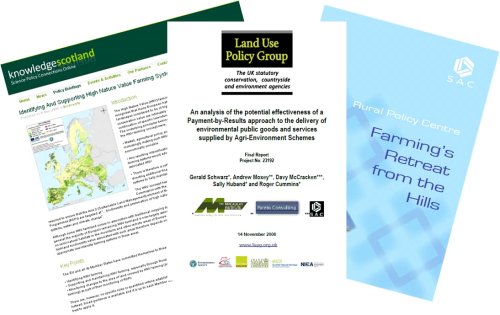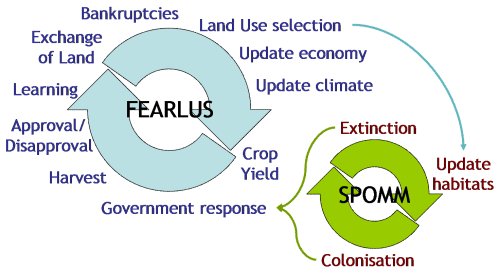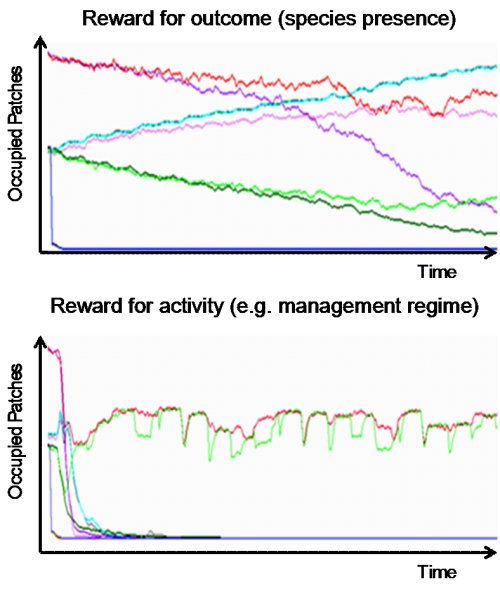|
|
Assessment of potential biodiversity impacts of future
policy changes
Our approach is based on various methods for exploring biodiversity in the context of various influences on behaviour, using GIS and agent-based modelling.
Informing the development of farmland biodiversity prescriptions and policies

Farmland is the dominant land cover in Scotland, and many of the habitats and species on which we place high nature conservation value are dependent upon the continuation of specific farming systems and practices. The intensification of farming systems over the last 40 years has had a negative impact on farmland biodiversity, especially that associated with cropping and grazing systems in lowland Scotland. Recent declines in livestock numbers on the Scottish hills and uplands have raised concerns that abandonment of farming practices will have further negative impacts on habitats and species intimately associated with upland livestock grazing systems. All of our farmland biodiversity research has the aim not only of improving understanding of farm management and biodiversity interactions but also of using the findings to develop and improve farmland biodiversity prescriptions and policies.
We are putting particular emphasis on highlighting the potential impacts of current policies on biodiversity and how any policy change could be best addressed from a biodiversity perspective. This forms part of a programme of work concerned with increasing scientific understanding of managing biodiversity change in the wider policy context.
Examples of such context setting include:
- McCracken, D.I. 2009. Farmland biodiversity: where do we go from here?. Platform presentation at Edinburgh Consortium for Rural Research conference focusing on Scotland’s changing rural biodiversity: policy and action needs, 9., Penicuik, and Aberdeen Research Consortium, Aberdeen.
- McCracken, D.I. 2009. Addressing farmland biodiversity declines: conflicts and cures. Invited contribution made to Electronic conference on biodiversity conflicts 11/5/2009
- Henle, K., Alard, A., Clitherow, J., Cobb, P., Firbank, L., Kull, T., McCracken, D.I., Moritz, R., Mühle, H., Niemelä, J., Nowicki, P., Rebane, M., Wascher, D., Watt, A. & Young, J. 2008 Identifying and managing the conflicts between agriculture and biodiversity conservation in Europe:- a review. Agriculture, Ecosystems & Environment 124, 60-71
- McCracken, D. 2009. Identifying and supporting High Nature Value farming systems. Knowledge Scotland Policy Brief,
- McCracken, D. & Klockenbring, C. 2007. Overview of the selection of biodiversity technical measures. MEACAP: Impact of Environmental Agreements on the CAP Project WP5 Final Report. 90 pp. DG Research Specific Targeted Research Project SSPE-CT-2004-503604
- McCracken, D., Klockenbring, C., Zdanowicz, A. & Baldock, D. 2005. Agricultural biodiversity: issue to be aware of within MEACAP. MEACAP: Impact of Environmental Agreements on the CAP Project WP5 Background Document. 24 pp. DG Research Specific Targeted Research Project SSPE-CT-2004-503604
- Schwarz, G., Moxey, A., McCracken, D., Huband, S. & Cummins, R. 2008 An analysis of the potential effectiveness of a Payment-by-Results approach to the delivery of environmental public goods and services supplied by Agri-Environment Schemes (23192). Report to the UK Land Use Policy Group (LUPG)
- SAC 2008 Farming’s retreat from the hills
Contact
A coupled modelling approach to explore biodiversity impacts of future policy changes

An agent-based model simulating individuals which can have different land use decision-making behaviours has been successfully coupled with a meta-community model of plant-species interactions. This enables potential biodiversity impacts to be modelled in relation to economic and social factors, for example, contrasting outcome-based and activity-based incentive schemes for their effectiveness and cost. Stylised scenarios have been used to test the model to date, indicating, for example, that outcome-based agri-environment measures are likely to be more effective at protecting biodiversity (but more costly) than activity-based ones. (Gimona et al. H. Ronald Pulliam Symposium, US-IALE, Madison 2008; Polhill et al. European Social Simulation Association, Brescia 2008).

Contacts
|
|